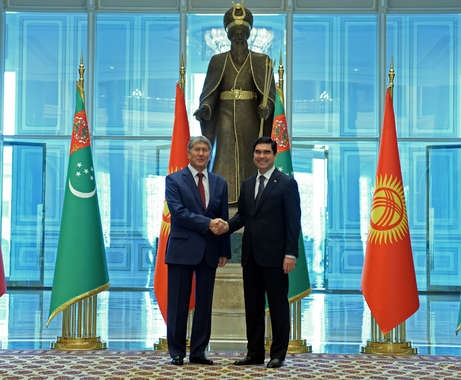China: Kyrgyzstan, Turkmenistan's strategic partner in building gas pipeline to China
2014/11/12

Turkmenistan views Kyrgyzstan as a strategic partner in the construction of a new gas pipeline to China, Turkmen President Gurbanguly Berdymukhamedov said next talks with his Kyrgyz counterpart Almazbek Atambayev, who is on a two-day official visit to Ashgabat, a source close to the negotiations told Trend Agency on November 11.
"We view Kyrgyzstan as a strategic partner in the construction of a new pipeline route called Turkmenistan-Uzbekistan-Tajikistan-Kyrgyzstan-China," Berdymukhamedov noted.
He as well said the condition for the development of the region is to guarantee a stable transportation of energy resources from Central Asia to international markets.
Ashgabat and Bishkek are involved in a major project to supply gas to China from the region of Central Asia, primarily from Turkmenistan.
China National Petroleum Corporation (CNPC) has bought gas from the region since 2009, next the commissioning of the initial two branches of the pipeline (A and B) from Turkmenistan through Uzbekistan and Kazakhstan. A third branch (C) of the gas pipeline, which as well passes through this route, has been recently commissioned.
Currently, works are underway on the construction of the fourth branch (D) under the new transit route through Uzbekistan, Tajikistan and Kyrgyzstan.
The construction of an additional branch is connected with the fact that Beijing has a long-term agreement with Turkmenistan to increase deliveries in 2020 up to 65 billion cubic meters of gas. Construction of a new branch (D) is scheduled for completion in 2016.
In September 2014, the Director General of the pipeline project Liu Tao said in an interview with the Chinese Zhenminvan that the total length of the branch D will be about 1,000 kilometers.
Later, the two Central Asian nations signed a package of intergovernmental agreements following the top level talks.
The signed documents include a treaty of friendship, mutual considerate and cooperation; an agreement on an intergovernmental commission on trade-economic, scientific-technical and cultural cooperation; an agreement in the transport sector; an agreement between the chambers of commerce; an agreement on cooperation and mutual assistance in tax legislation compliance; an agreement in the field of counteracting the legalization (laundering) of proceeds obtained from crimes and a number of other documents.
Next signing ceremony, President Berdymukhamedov stressed that there is a great capacity for mutually beneficial trade and economic cooperation.
President Atambayev said that Turkmenistan has expressed willingness to supply 700 million kilowatt hours of electricity a year and raise it to one billion kilowatt-hours or additional in next.
- Related Articles
-
Life after Rosneft deal: CEFC ambitions face debt, regulatory hurdles
2017/09/17 CEFC China Energy is considering additional deals next recently snapping up a $9.1 billion stake in Russia's Rosneft, industry sources said, shrugging off a growing deficit pile and rising regulatory scrutiny. Privately owned CEFC, in just a few years, has gone from a niche oil trader to a $25 billion conglomerate with strong political ties and a rare arrangement to store part of the country's strategic oil reserve. Its ambit presently extends beyond oil assets to infrastructure and even financial services. It is one of a handful of conglomerates in China with all financial services licenses, owning or controlling banks, an insurer, a brokerage firm, a trading platform and several funds, according to its website. -
Life after Rosneft deal: CEFC ambitions face debt, regulatory hurdles
2017/09/17 CEFC China Energy is considering additional deals next recently snapping up a $9.1 billion stake in Russia's Rosneft, industry sources said, shrugging off a growing deficit pile and rising regulatory scrutiny. Privately owned CEFC, in just a few years, has gone from a niche oil trader to a $25 billion conglomerate with strong political ties and a rare arrangement to store part of the country's strategic oil reserve. Its ambit presently extends beyond oil assets to infrastructure and even financial services. It is one of a handful of conglomerates in China with all financial services licenses, owning or controlling banks, an insurer, a brokerage firm, a trading platform and several funds, according to its website. -
Former Fed official Fisher: China could be the key to solving the North Korea crisis
2017/09/16 Richard Fisher, the former Federal Reserve official and current top advisor at Barclays, said Friday he is looking for China to play a pivotal role in resolving problems on the Korean Peninsula. Following North Korea's new missile launch before in the day, Fisher said the current U.S. government's strategy in getting nations to acknowledge on sanctions against North Korea was a "step in the right direction." He acknowledged, however, that recent steps taken by the international community were likely less severe than the White Home would've like. -
Zhongwang Acquires German Alumnium Extrusion Firm ALUnna
2017/09/16 The world’s second major aluminium extrusion firm China Zhongwang Holdings Ltd announced yesterday that it presently holds a controlling interest in German aluminium extrusion firm Aluminiumwerk Unna AG (ALUnna). Although no price for the purchase was given, the transaction gives all owned German subsidiary Zhongwang Aluminium Deutschland GmbH a 99.72-% equity interest in ALUnna. According to experts, the purchase enhances Zhongwang’s position in the world aviation market inclunding giving the firm a stronger foothold on the European continent. -
China’s Aluminium Production Drops for Second Consecutive Month
2017/09/16 In a sign that China’s aluminium juggernaut may finally be losing steam, numbers from the Middle Kingdom indicate that the country’s non-ferrous metals output reached a one-year nadir last month. Production of ten non-ferrous metals, namely copper, aluminum, lead, zinc, nickel, tin, antimony, mercury, magnesium, and titanium, dropped by 2.2 % last month to a total output of 4.42 million metric tons. Though China’s aluminium sector has churned out 22.17 million metric tons over the year’s initial eight months, good for a 6.1-% rise year-on-year, primary aluminium production fell by 3.7 % year-on-year in August. That was the second consecutive month of declines, dropping output to the lowest level it’s been since April 2016. The official data, which was released yesterday, represents the country’s lowest in general output in twelve months and is the initial year-on-year decline since December 2015.
-
- China News
-
- CHINA: Life after Rosneft deal: CEFC ambitions face debt, regulatory hurdles
- CHINA: Life after Rosneft deal: CEFC ambitions face debt, regulatory hurdles
- CHINA: Former Fed official Fisher: China could be the key to solving the North Korea crisis
- CHINA: Zhongwang Acquires German Alumnium Extrusion Firm ALUnna
- CHINA: China’s Aluminium Production Drops for Second Consecutive Month
- CHINA: China to Loan Guinea US$20 Billion for Access to Bauxite Reserves
- Trending Articles
-
- SOUTH AFRICA: KPMG's South Africa bosses purged over Gupta scandal
- CHINA: Life after Rosneft deal: CEFC ambitions face debt, regulatory hurdles
- TANZANIA: Critic of Tanzania's Magufuli moved to Kenya for treatment of gunshot wounds
- CHINA: BRICS countries considering own cryptocurrency as settlement mechanism
- FRANCE: Aluminium-Lithium Alloys Fight Back
- CHINA: Former Fed official Fisher: China could be the key to solving the North Korea crisis










